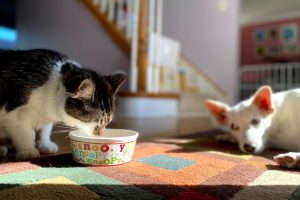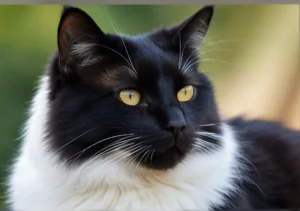Have you ever noticed your cat’s whiskers are curly at the end? Let’s uncover the mystery behind this unique feature.
Curly Whiskers: The Fascinating Reason Behind This Phenomenon
What are Cat Whiskers and Their Function?
Cat whiskers, also known as vibrissae, are specialized sensory hairs that are longer and stiffer than regular fur. These specialized hairs are deeply embedded in a cat’s body, making them more sensitive than other hairs. They are not only located on the muzzle but also above the eyes, on the chin, and even on the back of the legs.
The main function of cat whiskers is to help cats navigate their surroundings . They act as receptors that detect changes in their environment, such as the size of openings, movements of prey, and even changes in air currents. This sensory information helps cats in hunting, navigating in low-light conditions, and maintaining balance.
Why Do Some Cats Have Curly Whiskers?
Have you ever noticed that some cats have curly whiskers while others have straight ones? The curliness of a cat’s whiskers is determined by genetics. Just like humans inherit traits from their parents, cats can inherit curly whiskers from their ancestors.
Evolutionary reasons also play a role in why some cats have curly whiskers . Curly whiskers can sometimes benefit a cat in its natural habitat. For example, a curly whisker might be more sensitive to vibrations or changes in air currents, giving a hunting advantage to the cat.
Interestingly, certain cat breeds are more prone to having curly whiskers , such as the Cornish Rex or Devon Rex. The genetic makeup of these breeds can lead to unique coat and whisker qualities, including curls.
In some cases, curly whiskers can be a sign of a health issue , so it’s essential to monitor your cat’s whiskers for any changes. If you notice any drastic differences in your cat’s whiskers, it’s best to consult with a veterinarian to rule out any underlying problems.
Remember, the next time you see your cat with curly whiskers, appreciate the genetic and evolutionary reasons behind this unique trait. It’s just another fascinating aspect of the complex and mysterious world of our feline friends.
Can Curly Whiskers Indicate Health Issues?
Curly whiskers on your cat can actually be a normal phenomenon in most cases, but they could also be indicative of underlying health issues. Curly whiskers can sometimes signal nutritional deficiencies, skin allergies, or other health concerns that may need attention. If you notice a sudden change in the texture or curliness of your cat’s whiskers, it’s a good idea to consult your veterinarian for a thorough examination.
In some cases, curly whiskers may be genetic or breed-specific, so it’s essential to consider your cat’s overall health and behavior alongside their whisker appearance. While curly whiskers alone may not always signal a health problem, they can sometimes be a subtle indicator that something might be off with your furry friend.
If you observe other symptoms like changes in appetite, grooming habits, or energy levels, it’s advisable to seek professional guidance. Remember, your cat’s health is paramount, so always err on the side of caution when it comes to their well-being. Keep a close eye on any changes in their whiskers and behavior, and don’t hesitate to reach out to your vet if you have any concerns.
Signs that your cat’s curly whiskers might indicate a health issue:
- Unexplained weight loss or gain
- Decreased grooming habits
- Lethargy or decreased activity levels
- Changes in appetite or water intake
- Skin irritations or irregularities
If you notice any of these signs alongside curly whiskers, it’s essential to schedule a visit to the vet promptly for a comprehensive evaluation to ensure your cat’s well-being.
How to Care for Your Cat’s Curly Whiskers?
So, you’ve noticed your furry friend’s whiskers are curly at the end. No need to worry! Those curly ends are totally normal and actually serve a purpose. Cat whiskers are incredibly sensitive and help your cat navigate their surroundings, kind of like their built-in GPS.
To keep your cat’s curly whiskers in tip-top shape, make sure to provide a balanced diet rich in essential nutrients. A healthy diet can promote strong and vibrant whiskers. Additionally, regular grooming sessions can help keep your cat’s whiskers clean and prevent any tangles.
Avoid trimming your cat’s whiskers, as this can disrupt their sense of balance and coordination. Instead, embrace those curly whiskers as a unique feature of your feline companion.
Remember, your cat’s whiskers are not just for show – they play a crucial role in their sensory perception. Show your cat’s curly whiskers some love by providing them with the care they deserve.
Fun Whisker Facts!
Curly whiskers may have you intrigued, but did you know that a cat’s whiskers are actually twice as thick as their fur? Talk about some serious whisker power! These sensitive sensors can detect even the slightest changes in their environment, making them essential tools for your cat’s survival instincts.
Moreover, whiskers aren’t just on your cat’s face – they’re also found on their legs! These whiskers, known as carpal whiskers, help your cat gauge the size of openings and openings and navigate through dark or confined spaces.
Next time you admire your cat’s whiskers, remember they’re not just for aesthetics – they’re a vital tool in your cat’s daily life. Embrace the uniqueness of those curly ends and appreciate the incredible functionality behind every whisker on your feline friend’s face.
Curly Whiskers in Different Cat Breeds
Did you know that curly whiskers can vary not only in length but also in shape across different cat breeds? While some breeds have straight whiskers, others sport whimsical curls at the end. Breeds like the American Curl and the Cornish Rex are known for their unique curly whiskers, adding a touch of charm to their appearance.
These curls are often genetic and can be traced back to selective breeding practices. The genetic makeup of these breeds predisposes them to have these distinctive whiskers. So, if your feline friend has curly whiskers, it might be due to their breed lineage.
Moreover, environmental factors such as temperature and humidity can also play a role in whisker curliness. Dry environments may lead to more brittle whiskers that could develop a curl at the end. Keeping your cat’s environment well-moisturized can help maintain healthier, straighter whiskers.
Next time you take a closer look at your cat’s whiskers, marvel at the unique variations present in different cat breeds, each adding to their personality and charm.
The Evolutionary Significance of Curly Whiskers
Curly whiskers in certain cat populations might just have an evolutionary edge. The curl at the end of whiskers can enhance a cat’s sensory abilities, providing them with more sensitive touch receptors. These fine-tuned whiskers can aid in better navigation in dimly lit environments and help cats sense slight movements in the air, giving them an advantage in hunting and avoiding predators.
Interestingly, the curl in a cat’s whiskers can also act as a natural protective mechanism. The curve at the end of the whisker helps prevent damage to the delicate nerve endings present in these sensory hairs, ensuring that they remain intact and fully functional.
So, the next time you observe your cat’s curly whiskers, appreciate how these unique features have evolved to benefit them in their natural habitat, showcasing the wondrous ways in which nature equips our feline friends for survival and success.
Alex, a passionate animal lover, has experience in training and understanding animal behavior. As a proud pet parent to two dogs and three cats, he founded AnimalReport.net to share insights from animal experts and expand his knowledge of the animal kingdom.




